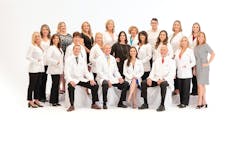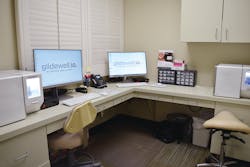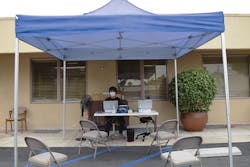My dental practice’s transition to in-office milling
Smiles4OC, our practice in Costa Mesa, California, has a reputation for being on the cutting edge when it comes to dental technology. As a busy and diverse practice with multiple doctors on staff (including my son Tim, our newest doctor), we’re lucky to have plenty of opportunities for research and development in new tools and technologies, and we eventually adopt the ones that let us provide the best care for our patients.
As we face the challenges of COVID-19 and the changes it has brought to dentistry, I’d like to share our practice’s journey since adopting digital technology and explain how these digital tools have helped us achieve our long-term goals.
Our history with digital dentistry
My digital journey actually began earlier in my career, when I helped design and bring to market an intraoral scanner. The company I worked for at the time was eventually sold to a major manufacturer in the dental technology space. While the scanner we made was effective, the techniques to use it were at the same time cumbersome and difficult. One of my roles in the process was to oversee the human trials for the scanner, and the crowns made from those digital impressions were excellent.
It was from this perspective that I continued to monitor new technologies in the pipeline for release throughout the dental industry. I knew that once digital dental technology reached a tipping point of quality and efficiency, our practice would be ready to invest in it and adapt our workflow accordingly.
That shift happened for my practice about two years ago, when we purchased the glidewell.io in-office solution. The investment allowed us to mill and deliver crowns in a single appointment, and our whole team learned how to integrate the new workflows that came along with these technologies.
This new service was so successful that we found ourselves having to limit the number of cases we treated, because the mill was constantly occupied and unable to keep up with the caseload. We began having to schedule patient visits around availability of the mill. Just when we were at the point of needing to address the issue, the COVID-19 shutdown occurred. This ended up being as fortuitous as the timing of such an event could be.
What do we want to do better?
While our practice was closed, our team began to ponder an important question: How could we best use this imposed period of downtime to improve our skills in an area that would benefit our patients the most? After some discussion, we agreed that the most efficient use of the time would be to improve our skills with the fastdesign.io, the proprietary proposal design software of the glidewell.io system. We set a goal of having some of our key staff members become true masters in the process of designing crowns to facilitate an efficient workflow for our in-office milling cases. This would prepare us for what we knew was coming once practices began to reopen—an increase in the number of patients who needed to visit the dental office all at once, combined with a need to limit the number of people in the office at a time for safety reasons.
This is what led us to purchase a second in-office mill. Along with other changes to our practice, such as the addition of COVID-19 screening for patients as they arrived for appointments, we felt we were preparing ourselves for the days ahead. We focused on longer appointments with more treatment accomplished per visit. Ultimately, we saw this as the best way to offer our patients and staff safety and peace of mind, while maximizing our ability to provide the most treatment to the most people in the most efficient way possible.
From then on, it was a simple matter of making some other adjustments around the office, including creation of a dedicated milling area for both of our milling units. We rehired a beloved hygienist who had been forced to retire due to COVID-19 exposure risk issues. We have positioned her in a kiosk outside the office to perform COVID-19 screenings while acting as a friendly, welcoming face to our patients as they arrive. The response from patients has been very positive.
How things are going now
Our practice has always been busy, so it’s a little hard to gauge how “back to normal” things are since the COVID-19 shutdown began. What is certain is that we have no shortage of things to do. In general, we feel our practice is in a fantastic position considering the challenges facing dentistry, and we owe that to the digital tools we have at our disposal. We are currently doing about 90% of our posterior restorations in-office with glidewell.io and our two fastmill.io units. And we’ve seen ways in which these technologies have improved our workflow, which is something we all appreciate.
The streamlined digital process we now have in place makes a huge difference. These days, as doctors in the practice, we can be working on two patients at once. We can send one case to the mill and start preparing a tooth on a second patient. Then, we basically leapfrog between the two. We’re much less dependent on the mill to dictate our schedule and the number of treatments we can accomplish in a given time frame.
With the help of the digital technology we have at our fingertips, we’ve seen the benefits of offering longer appointments with more dentistry performed at each appointment. The productivity we can accomplish during these appointments has greatly improved how our practice functions, and our patients are loving the benefits too.
The patient’s point of view
Anxious patients experience incredible stress when they have to come to the dental office for treatment that requires anesthesia. That stress is compounded when they have to return for a second appointment, whether or not concerns exist about the exposure risks for COVID-19. That’s why it’s wonderful to be able to mill these patients’ restorations in a single visit. This is a game changer for patients who face those levels of anxiety, and it comforts them to know we can get them through the whole process quickly and efficiently.
Moving forward
I haven’t done a full analysis of our return on investment since purchasing a second milling unit. We’re not overly concerned about ROI at this point. We know that the second mill will certainly pay for itself over time. The ability to mill nearly all of our single-unit posterior restorations in-office saves us time, materials, and costs (i.e., the cost of temporaries and seating crowns in separate appointments). All of this adds to our bottom line. To us, the important thing is that we’re treating patients as well and efficiently as possible while continuing to adapt to the requirements of this new landscape.
There’s a lot of nuance in dentistry, and I believe it’s important to keep changing and growing. Since the pandemic began, we have had a unique chance to rethink the way we do things, especially with regard to how we keep our patients, our staff, and ourselves safe. All of these things have suddenly become more important than ever.
About the Author

Thomas J. Rolfes, DDS, FAGD
Thomas J. Rolfes, DDS, FAGD, has been providing dental care in Costa Mesa, California, since 1984. He participates in several dental study groups and occasionally delivers lectures. Dr. Rolfes is licensed to provide IV and oral sedation.



